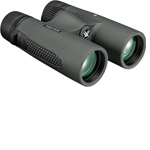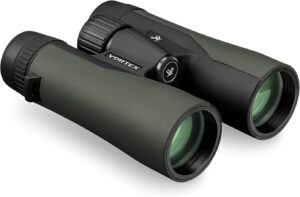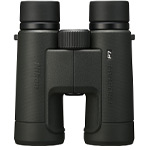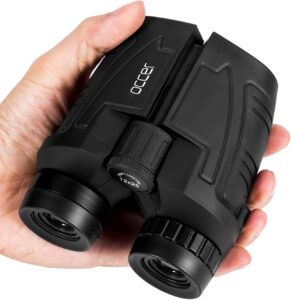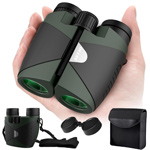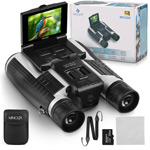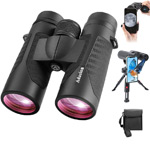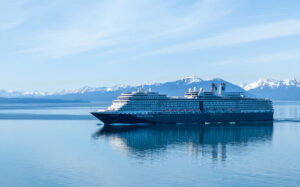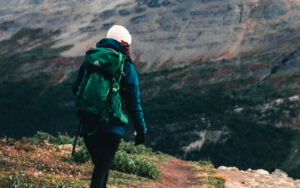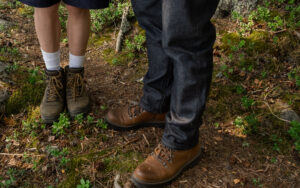
Alaska is a land of stunning natural beauty and abundant wildlife. Whether you want to see the northern lights, glaciers, mountains, or animals, you will need a good pair of binoculars to enhance your viewing experience. But how do you choose the best binoculars for an Alaska trip? Here are some factors to consider:
Note: This post may contain affiliate links. If you click a link and make a purchase, I may receive a small commission. All opinions are my own.
Size and Weight
You want something light and easy to carry so your neck doesn’t get tired and it fits easily in your bag.
Magnification and Brightness
Binoculars have numbers like 10×42. The first number tells you how close things will look. The second number tells you how bright and clear the image will be. Bigger lenses usually let in more light and help you see better in cloudy or rainy weather.
Picture Quality
Look for binoculars that say HD or multi-coated. That means the image will be sharp and colorful. Some are also great if you wear glasses.
Weather Ready
Alaska weather can be rainy, foggy, or cold. Waterproof and fog-proof binoculars with a grippy outer layer are great so you can keep watching even when the weather changes.
Extra Features
Some binoculars can be used with a tripod, which helps if you want to watch something for a longer time without holding them up.
You want a pair of binoculars that comes from a reputable and trustworthy brand, and that offers the best quality and performance for your budget. Some of the best brands for binoculars are:
Vortex: Is an American brand that is a family-owned and veteran-owned company. Vortex binoculars are famous for their quality, performance, and lifetime warranty. Vortex offers a range of binoculars for different levels of experience and expectations, from beginner to expert models.
Vortex Optics Bantam HD 6.5×32 Youth Binoculars
Compact HD binoculars that give bright, sharp wildlife views with a wide field of view, easy focus and rugged weatherproof protection. Ideal for travelers wanting powerful binoculars without the bulk on an Alaska cruise!
 Vortex Optics Copperhead 10x 42 Binoculars HD
Vortex Optics Copperhead 10x 42 Binoculars HD
Full-size HD binoculars with bright, sharp views, excellent low-light performance, waterproof durability and stable comfort. Ideal for cruisers wanting powerful glacier and wildlife viewing.
Vortex Optics Triumph HD 10×42 Binoculars
These Vortex Triumph HD 10×42 binoculars are full-size and easy to use, perfect for spotting whales, eagles and bears. They’re waterproof, fog proof and tough enough for Alaska weather. They come with a neck strap and harness for easy carrying on all your adventures.
Vortex OpticsCrossfire HD 10×42 Binoculars
These Vortex Crossfire HD 10×42 binoculars are a step up from the Triumphs with sharper views, better color and clearer edges. You can spot whales, eagles and bears in crisp detail. Waterproof, fog proof and easy to use with or without glasses. Perfect for Alaska!
Nikon 10×42 Binoculars
These binoculars are bright, sharp and built tough! They’re waterproof, fog proof, and resist smudges and rain on the lenses. Great for bird watching or spotting wildlife like eagles and bears. Comfortable to hold with a crisp, steady view every time.
Occer Binoculars
These are great little budget-friendly binoculars that are perfect for the whole family. They’re lightweight, easy to hold, and super clear for their size. Everyone can have a pair of their own, including the kids! A fun, affordable choice for any Alaska adventure!
15×30 Compact Binoculars for Adults and Kids
These small and portable binoculars provide 30% wider field of view for enhanced comfort, offering high light transmission, resulting in brighter, clearer and more complete images.
12×32 Digital Binoculars with
Video Camera
Binoculars and 4K camera in one! Zoom in on whales and glaciers, capture stunning photos and videos and enjoy Alaska without carrying extra gear. Perfect for travelers who want big memories made easy!
12×42 HD Binoculars with Phone Adapter
These 12×42 Adasion binoculars are a fantastic choice for your Alaska cruise. They’re lightweight, waterproof and come with a phone adapter and tripod, making it easy to capture what you’re seeing. With great clarity and a wide field of view, they’re perfect for spotting whales, eagles and glaciers from the deck or on excursions. A great value for the quality!
